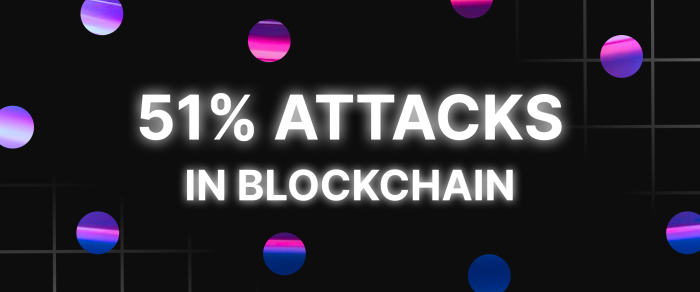Layer 1 vs Layer 2 Blockchain Scaling Solutions: What You Need to Know
As the blockchain industry evolves, so does the ingenuity of its scaling technologies. From Polygon’s Type 1 prover to Ethereum’s sharding proposals and consensus algorithm innovations, a growing number of innovative Layer-1 vs Layer-2 network solutions try to address the concerns of blockchain’s scalability.
But why does blockchain even need a scalability solution? And how do different approaches to resolving this problem compare?
Key Takeaways:
- Layer-1 solutions directly modify the fundamentals of the underlying blockchain to improve scalability.
- Layer-2 solutions build over existing blockchains to offload transactions and increase network throughput.
- Different types of scaling methods serve specific use cases and niches, contributing to the overall scalability of the system.
What Blockchain Layers Are There?
Before diving into the differences between these two scaling methods, we need to understand the blockchain layers.
Blockchain architecture consists of a series of interdependent layers, each with a distinct contribution to the functionality and security of the blockchain:
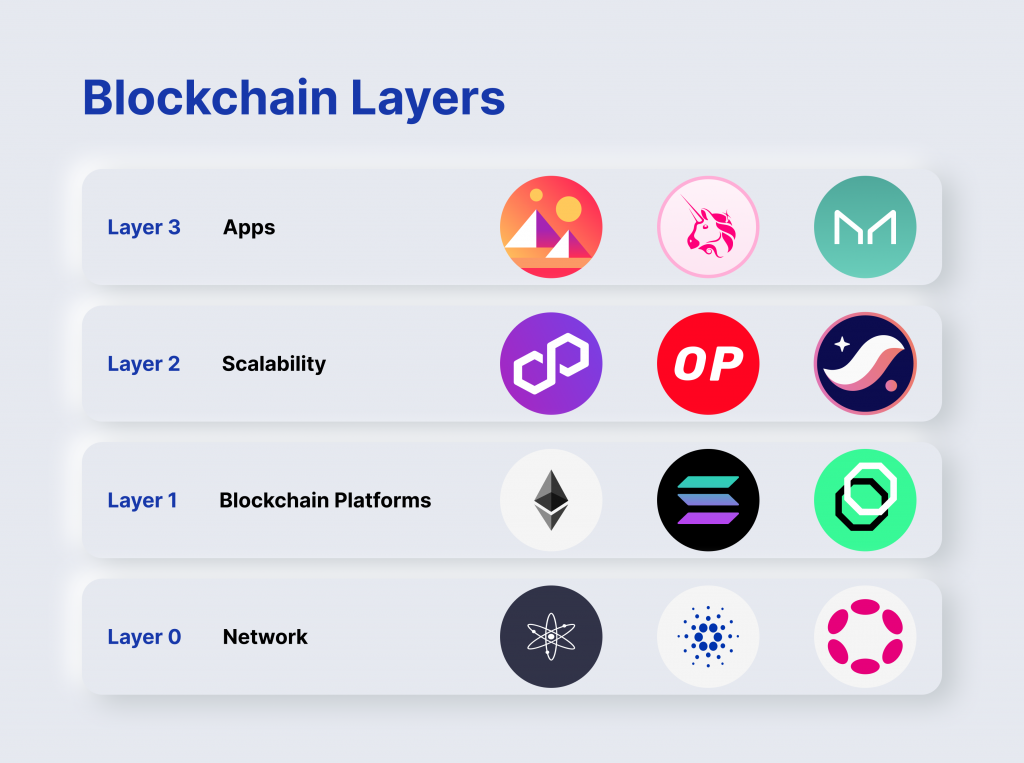
- Layer 0: This layer represents the foundational infrastructure, encompassing essential protocols and hardware components that collectively support the blockchain networks at the core.
- Layer 1: Also known as the implementation layer, it focuses on the native blockchain protocols. Layer 1 includes core aspects like dispute resolution and consensus mechanisms, underpinning the fundamental operation of blockchains.
- Layer 2: Also known as off-chain scaling solutions, Layer 2 offers better scalability by handling transactions off the main chain. They address constraints in the Layer 1 network, offering enhanced throughput and reduced transaction times.
- Layer 3: The application layer, where developers build dApps and where application-specific protocols provide the interface and functionality for a broad blockchain ecosystem.
What Is the Blockchain Trilemma?
Blockchain developers grapple with the persistent challenge known as the Blockchain Trilemma. It describes the intricate balancing act of bolstering a network’s decentralisation, security, and scalability without sacrificing any single attribute.
As blockchain technology seeks to revolutionise numerous industries, the quest to establish networks that excel in all three areas remains the ultimate goal but is often elusive.
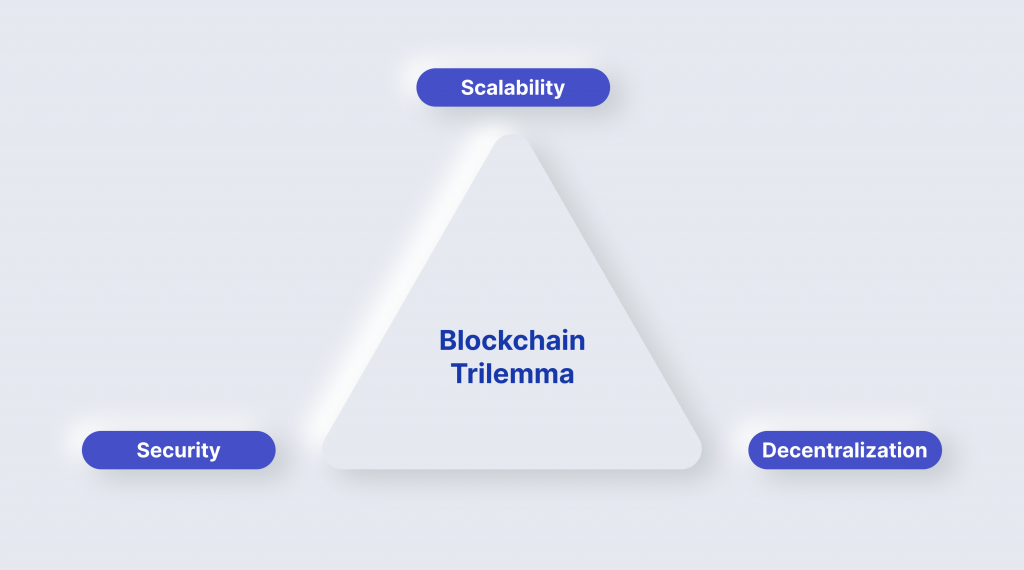
Decentralisation
This foundational blockchain principle eliminates intermediaries, reducing the potential for a single point of failure or control. Yet, as the degree of decentralisation increases, it often leads to a reduction in network throughput, presenting a significant obstacle to achieving the desired transactional agility.
Security
Given the high stakes involved in the blockchain sector, especially in financial applications, robust security measures and transaction data privacy are some of the most important components of the ecosystem.
In this context, security is critical in preventing 51% of attacks. These attacks occur when a single entity gains majority control of a network’s mining power, thereby exposing the network to fraudulent transaction manipulation.
However, achieving this necessary level of security can sometimes create challenges regarding scalability and decentralisation, particularly in proof-of-work networks.
Scalability
Scaling blockchain networks while preserving these two principles is challenging for developers. As users increase, networks struggle to keep pace with demand, leading to network congestion that causes transactions to take longer to complete.
Additionally, scaling requires sacrifices in decentralisation and security as more nodes are added to the network, which almost always leads to slower transaction speeds.
Two major approaches have emerged to address the Blockchain Trilemma: Layer-1 solutions and Layer-2 solutions. Let’s examine how scalability issues are addressed today on different levels of blockchain.
Layer-1 Scaling Solutions: Upgrading the Base Protocol
Layer-1 scaling solutions fundamentally enhance the base protocol of blockchain networks, grappling with the inherent challenges of increasing transactional throughput while maintaining robust security and decentralisation.
These solutions are directly built into the main blockchain protocol – the bedrock upon which all else is constructed, thereby fortifying the core without relying on external frameworks or systems.
Types of Layer-1 Scaling Solutions
Key approaches to Layer-1 scaling include:
- Block Size Increase: A seemingly straightforward solution which implies raising the block size to allow for a greater number of transactions within each block. However, this tactic requires careful calibration; excessive increases can burden node operators, potentially compromising decentralisation.
- Block Time Reduction: By decreasing the time interval between the creation of blocks, networks can process transactions more rapidly. This requires a delicate balance to ensure network stability and security.
- Sharding: A progressive solution that segments the blockchain into smaller, easier-to-manage pieces or “shards,” each able to handle transactions independently and in parallel. The outcome is a multiplier effect on the efficiency of the blockchain network, pushing up transaction rates without inundating any single node with excessive data.
- Consensus Model Transition: A more effective consensus protocol like proof of stake (PoS) can not only decrease the energy consumption associated with transaction validation as compared to proof of work but also streamline the validation process to accommodate more transactions.
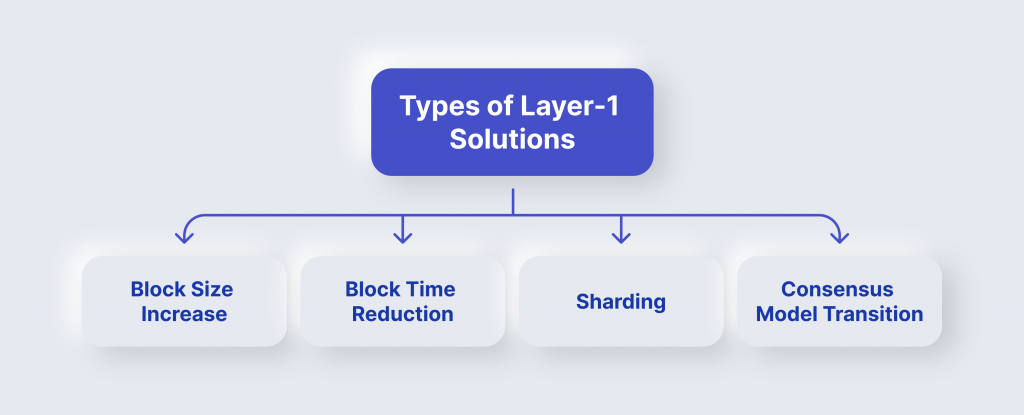
Examples of Implemented Solutions
Renowned examples of Layer-1 scaling solutions at work include:
- Ethereum’s shift from PoW to PoS in its Ethereum 2.0 upgrade, coupled with the implementation of shards.
- Cardano’s unique Ouroboros PoS consensus mechanism designed for scalability without sacrificing security.
- Bitcoin’s implementation of Segregated Witness (SegWit) helped to optimise the space within each block, indirectly allowing more transactions to be included.
While Layer-1 scaling solutions usher in advantages such as lowered transaction fees, direct refinement of consensus protocols, and upheld decentralisation, they also present constraints.
Miners might face revenue drops as the system becomes more efficient, nodes may face storage and bandwidth issues, and shard traffic management remains a challenging task. Despite this, Layer-1 scaling is evolving, with new Layer-1 networks becoming robust enough to handle the burgeoning demand for scalability.
Layer-2 Scaling Solutions: Building on Top of Existing Blockchains
Layer-2 scaling solutions enhance blockchain scalability by building on the foundational Layer-1 protocols.
These solutions are instrumental in offloading the bulk of data from the congested main chain. Notably, creating an off-chain transaction channel facilitates the development of more intricate applications that necessitate high-frequency and low-cost transactions.
Types of Layer-2 Scaling Solutions
The broad spectrum of Layer-2 solutions includes:
- State Channels: These allow participants to conduct numerous transactions off-chain, only settling the outcome on the blockchain. Examples include the Lightning Network for Bitcoin and the Raiden Network for Ethereum, which provide instant transactions at lower fees.
- Zero-Knowledge Rollups (zk-Rollups): Solutions like zkSync and Hermes Network efficiently bundle a multitude of transactions into a single transaction. These employ Zero-Knowledge Proofs to preserve the integrity and verifiability of transactions without exposing details on the main chain.
- Optimistic Rollups: These facilitate off-chain transaction processing and return only condensed information to the main chain. Projects like Optimism and Arbitrum Rollup lean on the security of the underlying Layer-1 network for asset protection.
- Sidechains: Frameworks such as the Liquid Network for Bitcoin and xDAI Chain for Ethereum exist in parallel to the main chain, creating avenues for asset portability and exchange without burdening the main chain.
- Plasma: Plasma constructs additional child chains, increasing transaction capacity for networks like Ethereum.
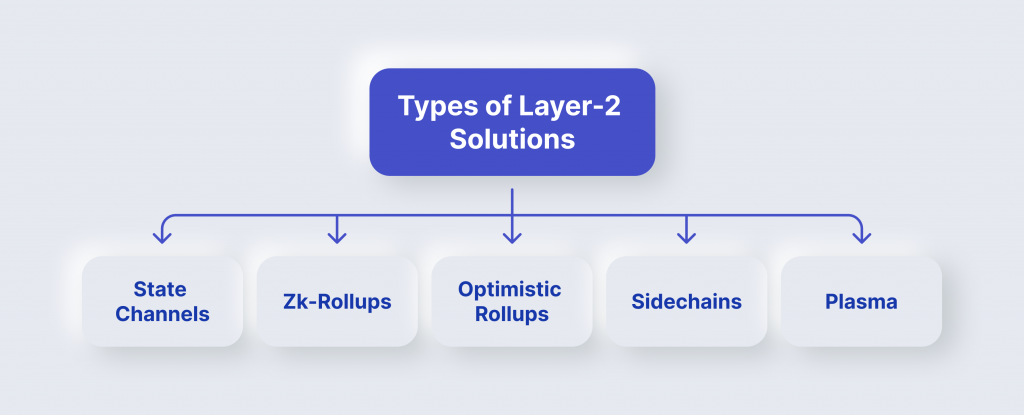
These Layer-2 scaling technologies allow blockchain layers to scale effectively while preserving the core attributes of decentralisation and security embedded in Layer-1 protocols. Moreover, these approaches ensure that a certain blockchain still supports an ever-increasing range of decentralised applications in its ecosystem.
Different Layer-2 scaling solutions serve specific niches:
- State Channels are optimal for transactions that require speed and frequent interaction.
- Sidechains introduce the flexibility of customised consensus mechanisms suitable for scenarios that demand unique governance models.
- Plasma excels in applications with high-volume transactions, ensuring efficiency without overwhelming the main chain.
- Rollups, both Zero-Knowledge and Optimistic, address computational constraints, enhancing scalability and decreasing load on Layer-1 networks.
Layer-1 vs Layer-2 Scaling Solutions
In the face of an ever-expanding universe of blockchain technology, the discourse on scalability solutions has become a cornerstone in the blockchain community. Layer 1 and Layer 2 scaling solutions each address the need for expanded network capacity, yet they embody different approaches.
Layer 1 protocols improve the blockchain’s underlying code to enhance the speed of transactions and network performance. This often involves:
- Direct changes to blockchain’s consensus algorithms, such as the transition from the power-hungry PoW to the vastly more efficient PoS, transform the way blocks are validated and mined.
- The implementation of sharding techniques, wherein the blockchain is partitioned into smaller, more manageable pieces, enables simultaneous processing and thereby multiplying the transactional capacity of the network.
Layer 2 solutions, on the other hand, develop a parallel system architecture to deal with the flood of transactions without altering the underlying blockchain protocol:
- Rollups collect numerous transactions into a single data block before synchronising with the main blockchain, drastically reducing the number of transactions that need to be individually recorded.
- Sidechains function as independent blockchains linked to the primary chain through smart contracts, operating autonomously but requiring users to entrust the sidechain’s governance.
- State channels establish a private communication channel for parties to transact freely off-chain, broadcasting only the final state to the blockchain for validation purposes.
- A nested blockchain introduces a hierarchy of chains, where secondary chains, or ‘child chains’, execute transactional processing under the strategic direction invoked by the ‘parent’ blockchain.

The contrast in strategies between Layer-1 and Layer-2 solutions is stark. However, despite their distinct mechanisms, both Layer 1 and Layer 2 solutions share the ambition of accelerating blockchain networks and expanding their capacity.
Closing Thoughts
These scaling solutions are not only instrumental in addressing the growing pains of blockchain’s rapidly expanding digital economy but also serve as testaments to the innovative spirit that propels the industry.
As blockchain continues its relentless march towards mainstream adoption, the harmonious interplay between Layer 1 protocols and Layer 2 scaling technology will undoubtedly be pivotal in shaping a resilient, versatile, and scalable blockchain infrastructure.
FAQs
What are consensus algorithms?
Consensus algorithms are the set of rules that determine how transactions are verified, added to the blockchain, and ultimately agreed upon by all network participants. The two most common consensus methods in the industry are proof of work and proof of stake.
What is on-chain and off-chain scaling?
On-chain scaling refers to the process of increasing transactional capacity directly on the blockchain, whereas off-chain scaling involves utilising secondary protocols or technologies to handle transactions outside of the main chain.
Are there any potential drawbacks to Layer-2 scaling solutions?
Layer-2 solutions may introduce additional complexity and require trust in off-chain processes, which can be seen as a trade-off for increased scalability. Additionally, implementing and adopting these solutions may take time and resources.

